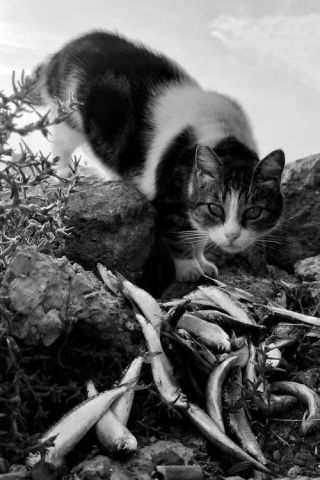Animal Behavior
Horses and Humans: Prey vs. Predator?
The biological classification of horses as prey and humans as predator species.
Posted June 6, 2024 Reviewed by Gary Drevitch
Key points
- Prey and predator are biological classifications based on eons of evolution. We cannot escape them.
- Executive functions like analyzing, deciding, and thinking get prey animals killed.
- Horses are prey, and humans are predators, yet we cooperate closely.
- Because they are large, strong, skittish prey animals, horses are difficult to study.

One of the most controversial aspects of my work exploring the relationship between horse and human brains is the distinction between predator and prey. Most people do not appreciate being called “predators,” despite the fact that the entire species of homo sapiens belongs to that biological classification. There are many hallmarks of predator animals; the easiest to identify is that we have frontal-facing eyes. Prey species, on the other hand, have eyes that face outward to each side. Think of a rabbit, a deer or elk, and, yes, a horse.
Prey animals also travel and sleep in groups rather than alone. The horse’s herd, for example, is a hallmark of his biological classification as prey. The herd is necessary for equine protection, allowing only a few individuals to remain vigilant while others sleep, eat, reproduce, or play. When these equine lookouts perk up their ears or turn their heads suddenly, other horses observe their reactions. If the sentinel shies or begins to run, you can bet her herdmates will follow suit immediately. Their brains are hard-wired to carry out that action.
Executive function of the kind produced by the human prefrontal cortex is important in predator species but detrimental in prey species. These functions include reasoning in analytical steps, thinking logically, setting goals, considering options, making decisions, manipulating emotions, strategizing for the long term, and assessing risk. For a prey animal, they waste valuable survival time. When you could become a predator’s dinner, it pays to run away at the slightest sign of danger. Prey animals who stand around and ponder the situation are caught and killed.
To those who argue that present-day humans are not predators and today's horses are not prey, my apologies. Our brains—both horse and human—were designed through evolution a long, long time ago. And evolution always lags behind the present. Many people still get red in the face, our blood pressure spikes, and our hands tingle from episodes as safe as standing in a line or waiting in traffic. That's the evolutionary human sympathetic nervous system at work...in a new setting where it is harmful rather than helpful. You might not live as a predator today, and your horse might not live as prey—but we still have predator or prey brains.
Horses and humans are a remarkable pair because of the prey/predator distinction. First, prey and predators rarely work together, yet horses and humans cooperate frequently. Second, prey and predator brains operate in ways so distinct that it’s hard to imagine how they can share information. Yet we do, every day. Third, very little study has been aimed toward prey animals. Popular books on animal cognition focus almost exclusively on predators—dogs, cats, whales, dolphins, chimpanzees, gorillas, orangutans, hawks, and so on—because predators are the animals most scientists study.
Why has the study of equine science been slow to develop, despite horses' impressive contributions to human civilizations for thousands of years? There are several reasons. Egocentrism is one of them: We are more interested in predators because they are like us. They are easier to understand also, because they are like us. We assume they are more important, again, because, well, they are like us.
But equine studies are also delayed because horses are difficult to study in traditional settings. Horses living in the wild escape human observation quickly. Those in captivity aren’t much easier. The average working horse weighs 1200 pounds and stands about 6’ 5” high at the top of the ears, unless he's alarmed, when his head raises much higher. He is fragile, prone to digestive distress, respiratory diseases, and leg injuries. He is skittish—unlikely to allow neophytes to touch or move him. He is uniquely suited to determine his own behavior. Have you ever tried to make a 1200-pound prey animal cooperate with you? It’s not easy unless you have the skills and experience. And even then…
All of these traits mean that equine caretakers must be educated and experienced. The person who can pour some pellets into the cage of a lab rat knows nothing about the complex care and feeding of a horse. Legal liability is an enormous hurdle. Horses are inherently dangerous because of their size, power, and agility—they can spin left, right, forward, back, and upside down in the blink of an eye. And with no capacity for risk assessment, they can kill or injure humans very easily, with no intent to harm. Not many scientists or university labs are willing to accept the time, expense, or legal risk necessary to investigate equine behavior.
The horse’s natural tendency toward fear plays a role also. A fearful animal the size of a horse cannot be trained to enter a magnetic resonance imaging machine where hundreds of drums from “Sympathy for the Devil” seem to be thumping at high volume. Nor would it be ethical to try. So we study horses in other ways, doing our best to understand how prey and predator brains can possibly cooperate to such a great extent.


